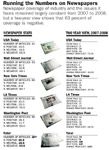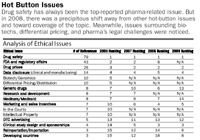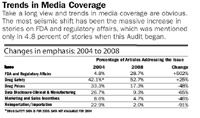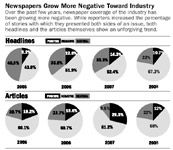Fifth Annual Press Audit: Safety in the Spotlight
Pharmaceutical Executive
Reporters pass on the typical litany of lightning-rod issues and instead devote more than three-quarters of all coverage in 2008 to drug safety-and the regulators who enforce it.
There may be fewer articles about the pharma industry these days—but the stories that do run are increasingly negative and one-sided. What's more, according to the results of the Fifth Annual Press Audit of issues in the pharmaceutical industry, while media coverage of pharma's marketing, sales, and other promotional practices has ebbed, it's been replaced with an almost laser-like focus on drug safety.

Running the Numbers on Newspapers
This annual audit, sponsored by the Arrupe Center for Business Ethics at St. Joseph's University, tracks and analyzes how the media covers industry issues. Each year, the audit identifies the "hot button" issues attracting media attention, compares how these issues are now covered in previous years, and reports on the pharmaceutical companies and brands most often cited in the news. This year, for the first time, we've turned the tables to focus on how each newspaper in the study presented the industry.
Top findings for 2008 include:
- Coverage is down 45 percent when compared to 2006 and 2007.
- The press coverage the industry receives is more negative than ever, with only 12 percent of articles deemed "positive" for pharma. The New York Times was the most negative toward the industry, followed by USA Today and The Washington Post.
- Drug safety continues to be the hot button issue, with the number of articles at a five-year high.
- Merck and its brands attracted the most media attention of any pharmaceutical company.
Processing the News
The Fifth Annual Press Audit analyzed content from the top five US newspapers (as defined by total circulation) for the 12-month period ending October 1, 2008, and identified all front page and editorial articles pertaining to hot-button pharma issues. The newspapers were USA Today, The Wall Street Journal, The New York Times, the Los Angeles Times, and The Washington Post. We focused on daily newspapers rather than broadcast media or weekly magazines because of newspapers' ability to cover a broader range of issues with more depth than the sound bites reported on radio and TV. Business and news magazines are constrained by their weekly or monthly formats. The purpose of the audit was to shed light on the following questions:
- What ethical and legal controversies face the pharma industry—and what kinds of coverage do they attract?
- Do the articles and headlines support or oppose the positions taken by the industry, as defined by PhRMA (the Pharmaceutical Research Manufacturers Association)?
- How often do reporters include the industry's perspective in stories that cover the issues of the day?
- What pharmaceutical companies and brands are identified and discussed in the articles?
- How do the newspapers compare to each other in the stance each tends to take toward the industry?
- What does all this coverage mean for the pharmaceutical industry?

Hot Button Issues
For each article, we examined four elements:
Issues We identified and categorized the hot button issues (as defined by PhRMA) that were discussed in each article. Many articles covered two or more issues that were included in relevant sections.
Headlines We analyzed headlines and categorized them as positive, negative, or neutral toward the industry. For example, "Costly Drugs, Unfair Burdens" (New York Times, April 20, 2008) was classified as a negative headline, while "A Shot at Stopping AIDS" (Washington Post, December 18, 2007) was labeled positive.
Tone We analyzed each article to determine whether it took a positive, negative, or neutral position toward the pharmaceutical industry. For example, an article that called for restrictions or a prohibition on direct-to-consumer (DTC) advertising—a position that the industry opposes—was deemed negative. In contrast, an article that claimed that DTC advertising resulted in more informed patients was designated as positive.
Balance Regardless of the dominant position in a news article or editorial, we looked to see if stories included opposing points of view. When an explicit statement about an opposing viewpoint was included in the article (even if the two sides did not receive equal coverage), we concluded that the article covered both sides. When no mention of the opposing view was presented, the article was labeled one-sided.

Trends in Media Coverage
What Are the Hot Button Issues?
"Running the Numbers on Newspapers" (left) shows the number of articles published in 2008 compared with 2007. The overall results indicate that the amount of coverage the pharma industry received remained about the same from 2007 to 2008 (150 articles versus 147). Rather, the more apparent change is the difference in coverage rates in the two-year period of 2007–2008 compared with 2005–2006; in 2007–2008, newspaper coverage declined 45 percent.
"Hot Button Issues" (right) identifies the topics media covered and their frequency, and compares those numbers to previous years. For the past five years, drug safety has been the top magnet for coverage. In 2008, the focus on drug safety intensified even more. More than half of all articles on the industry addressed the issue of drug safety. Most of those articles were critical of the industry and/or a specific company or brand.

Newspapers Grow More Negative Toward Industry
The focus on FDA and regulatory affairs, a related issue, also continued to grow, and moved into second place on the list, surpassing the emphasis on drug prices for the first time in the five-year period of the study. Biotech also emerged as a strong focus in 2008, moving from unranked to fifth on the list.
Further down the list were three pricing related issues: high drug prices, importation/reimportation of drugs, and differential pricing and distribution. Comparing the bookend years of the study—2004 vs. 2008—you can see how the focus on high drug prices has waned. (See "Trends in Media Coverage," right.) High drug prices were emphasized in one-third of all articles in 2004, but in only 17.3 percent of articles in 2008—a decline of 92 percent. Similarly, importation or reimportation of drugs to the US was a clarion call in 2004, but hardly warranted a whisper in 2008. The emphasis on data disclosure in clinical trials and manufacturing also dropped precipitously, appearing in 26.7 percent of articles in 2004, but only 9.3 percent in 2008.
Negative Coverage
The overall drop in coverage is good news for the industry, as media coverage tends to be negative toward pharma. This negative slant has been constant over the five years of the study, but is even more pronounced in 2008. Both headlines and articles became more negative, while the percentage of positive articles dropped from 29 percent to only 12 percent.
Much of this change can be attributed to highly publicized drug safety cases reported in 2008 ("Report: Data on Vioxx Misused; Documents Suggest Risk Was Downplayed," USA Today, April 16, 2008), along with the increased scrutiny of FDA ("FDA Says It Approved the Wrong Drug Plant; Heparin Probe Sends Inspectors to China," Washington Post, February 19, 2008). In addition, articles such as "Big Pharma Faces Grim Prognosis; Industry Fails to Find New Drugs to Replace Wonders Like Lipitor" (Wall Street Journal, December 6, 2007) and "Pharma's Queasy Feeling; Overdependence on 'Blockbuster' Drugs Is Taking a Toll on the Industry" (Los Angeles Times, January 27, 2008) contributed to the negative skew.
Which newspapers view the industry most negatively? For the first time, this year's audit examined this question by analyzing all 297 articles collected in the EthicsTrak database over the past two years. The results indicate that coverage in The New York Times is the most negative toward pharma by a significant margin, followed by USA Today and The Washington Post. The Wall Street Journal is most likely to publish a positive article about the industry.
Regardless of whether the article takes a primarily positive or negative tone toward the positions of the industry, our audit analyzed whether both sides of the disputed issue were acknowledged. It's important to note that all the analyses of articles over the past two years that resulted in a "negative" assessment included both sides of the issue.

Companies Under Watch
Inked Companies
Drug companies and/or their products were named 113 times in the study. Five companies accounted for 78 percent of those references. Merck led the way with 31 mentions in 2008, mostly due to residual issues linked to Vioxx ("Merck's Tactics Largely Vindicated as It Reaches Big Vioxx Settlement," Wall Street Journal, November 10, 2007). As the year progressed, Merck's overzealous marketing of their heart drug, Zocor (Washington Post, February 2, 2008), its $650 million Medicare settlement (Washington Post, February 8, 2008), and the clinical failure of its HIV vaccine (Washington Post, March 21, 2008) received coverage.
Other coverage of Big Pharma companies included:
- Pfizer, which was a distant second with 19 mentions resulting from coverage of several issues led by the termination of Lipitor's spokesman, Dr. Jarvik, as well as questions about the performance and positioning of several of its drugs—Lyrica, for the treatment of fibromyalgia (New York Times, January 14, 2008); Chantix, for smoking cessation, restricted from use by pilots (USA Today, May 22, 2008); and the failure of the company's insulin clinical study (Wall Street Journal, October 19, 2007).
- Schering-Plough was named 14 times, tied to concerns about the safety of their heart drug Zetia (coverage with Merck in USA Today, July 25, 2008), the failure of a cholesterol clinical trial (New York Times, January 16, 2008), and allegations about data suppression (USA Today, February 1, 2008).
- Johnson & Johnson's coverage was largely based on safety concerns and its cold remedies for children (Los Angeles Times, October 12, 2007), but also included coverage about "behind the counter" use of its products (Los Angeles Times, October 5, 2007).
- Baxter coverage focused almost exclusively on the problems related to the safety of heparin (Wall Street Journal, February 21, 2008).
This coverage is summarized in "Companies under Watch," page 34.
Future Implications
This year's media coverage put emphasis where it needed to be: squarely on drug safety. More than half (79 of 147) of the articles addressed that topic. While some offered residual coverage about Vioxx, the majority drew attention to newly emerging safety issues, such as those related to the heparin supply. Furthermore, most of the 43 articles about FDA concerned the agency's ability to safeguard drugs. This means a full 83 percent (112 of 147) of press coverage in 2008 was directed to safety concerns.
Restoring confidence in the safety of drugs is paramount for industry. Under the leadership of Acting Commissioner Frank Torti, FDA seems poised to continue Andrew Von Eschenbach's emphasis on drug safety. A key question is whether FDA will get a budget that enables a greater separation from industry's funding of approval evaluations under the Prescription Drug User Fee Act (PDUFA). The recent expansion of PDUFA introduces goals to prevent look-alike and sound-alike proprietary names, as well as unclear label abbreviations and acronyms. Given FDA's limited resources, this has the potential to dilute their attention in areas crucial to drug safety, such as companies' production processes and ingredient suppliers.
This year's audit offers a perspective on the way different newspapers cover the industry. As mentioned earlier, The New York Times is clearly the most negative toward pharma, followed by USA Today. That being said, the negativity is often warranted, such as the coverage of overpromoted cholesterol drugs (New York Times, April 2, 2008). Furthermore, our data indicate the media at least mentioned the industry's position in every negative article of the last two years.
Given the changing times, no analysis would be complete without discussing the impact of healthcare reform on the pharmaceutical industry. In parallel with President Obama's work on the economy and foreign policy, proposed reforms for US healthcare are clearly topping the agenda. First, take Medicare Part D. Here, two options have important implications for pharma. One is closing the infamous doughnut hole. While such a measure would be popular with enrollees and a potential source of increased drug sales, its projected cost is about $300 billion over 10 years—suggesting that the hole may be made smaller but not necessarily close altogether. Second, Medicare may need the latitude to negotiate drug prices directly with pharma companies instead of allowing insurers to negotiate separately with pharma companies. Wal-Mart charges $4 for about 500 different drugs, and is making money on their pharmacy sales. Adjusting Medicare to conduct direct negotiations with pharmaceutical manufacturers would be more complex than Wal-Mart's negotiations with its pharma suppliers, but it could be done.
In both situations, Big Pharma would bear a substantial portion of the cost of these changes through lower negotiated drug prices. This means, as an industry, pharma would have to learn to operate on lower profits—a behavior not inconsistent with indicators in this business environment. While this may be challenging for the development of innovative new medicines, it may also help to reduce negative media attention, especially about drug pricing, and to avoid further governmental regulation such as price controls.
Along that line, the life sciences industry continues to make significant efforts to police itself, such as the introduction of more stringent PhRMA guidelines in January 2009. However, Eli Lilly's recent $1.4 billion fine for off-label promotion of Zyprexa isn't the way to convince the stakeholders concerned about healthcare in the United States. More about this in next year's pharmaceutical media audit.
Stephen J. Porth is an associate dean and a fellow and professor for the Arrupe Center for Business Ethics at Saint Joseph's University. He can be reached at sporth@sju.edu. George P. Sillup is an Arrupe Fellow and an assistant professor at Saint Joseph's University. He can be reached at sillup@sju.edu. Cynthia Slater, Molly Porth, Leanna Baselice, and Courtney Scardellette also contributed to this research.

The Misinformation Maze: Navigating Public Health in the Digital Age
March 11th 2025Jennifer Butler, chief commercial officer of Pleio, discusses misinformation's threat to public health, where patients are turning for trustworthy health information, the industry's pivot to peer-to-patient strategies to educate patients, and more.
Navigating Distrust: Pharma in the Age of Social Media
February 18th 2025Ian Baer, Founder and CEO of Sooth, discusses how the growing distrust in social media will impact industry marketing strategies and the relationships between pharmaceutical companies and the patients they aim to serve. He also explains dark social, how to combat misinformation, closing the trust gap, and more.